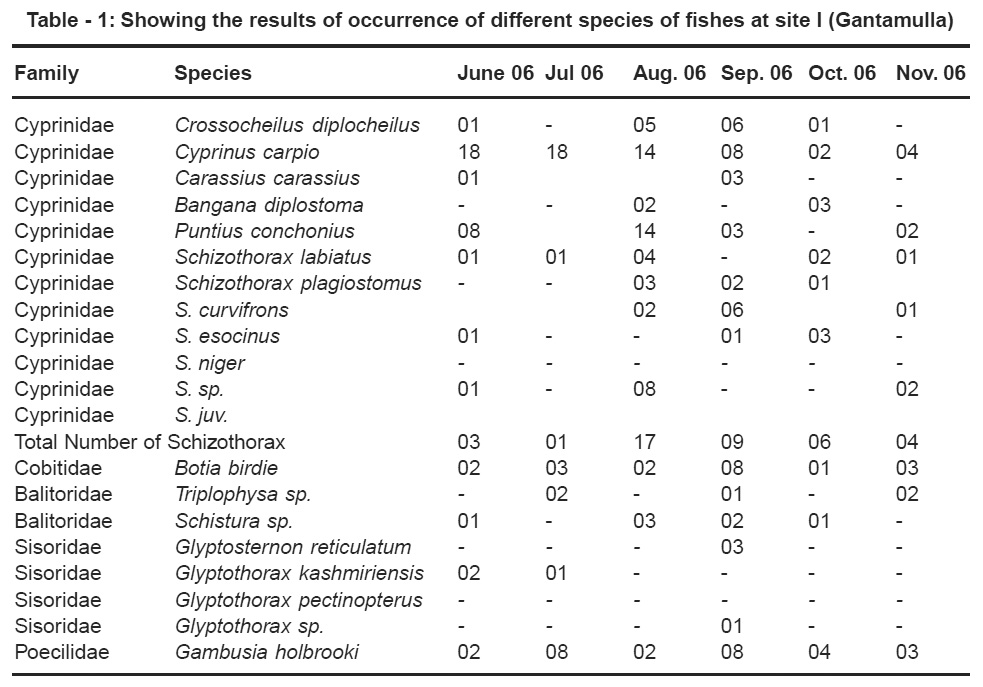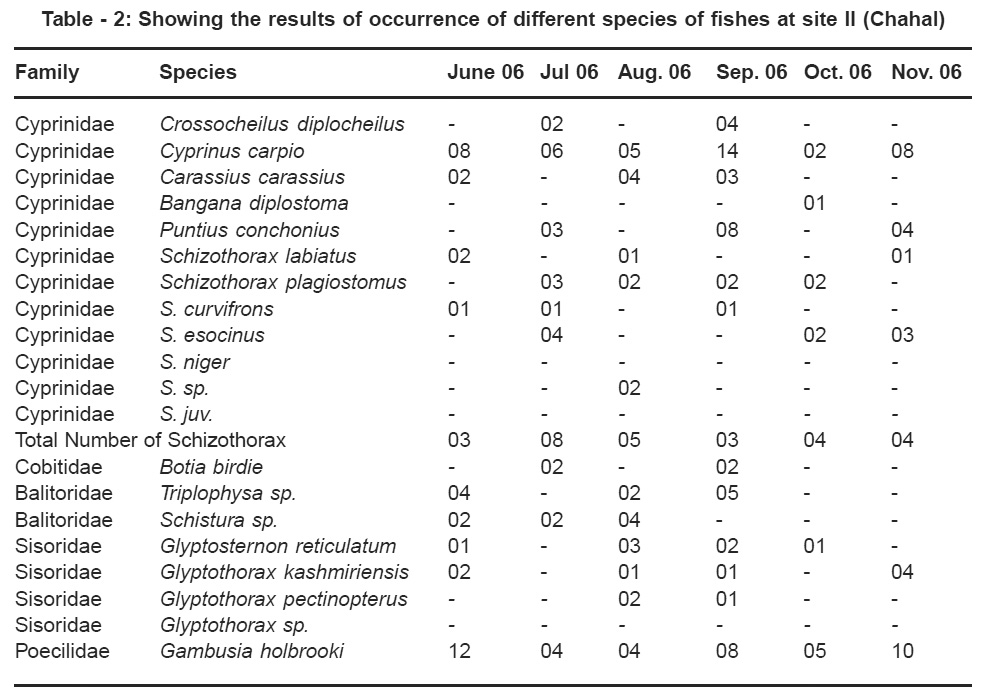Effect of lower Jhelum hydroelectric power project on finfish diversity of river Jhelum, j & k.
Tanveer A. Qureshi * , Salman R. Chalkoo , K. Borana , S. Manohar , Syed Shahzada Mudaser and T.A. Qureshi
1
Department of Applied Aquaculture,
Barkatullah University,
Bhopal,
462 026
India
DOI: http://dx.doi.org/10.12944/CWE.2.1.08
Lower Jhelum Hydroelectric project under the programme of Uri hydroelectric power project Baramulla J & K, was commissioned three decades ago on River Jhelum. At this segment of river, 18 species of fishes have been recorded. After the commissioning of this project several deteriorative environmental effects have been noticed on the aquatic biodiversity of this river. This project exerted highly adverse effects on the population of mighty Mahaseer, Tor putitora (Golden Mahseer), which flourished a lot in the past but diminished so much so that it has come under endangered category of fish species. As such Schizothorax plagiostomus, S. curvifrons, S. esocinus, S. labiatus are also affected adversely and now are scarce in catches. Two major factors may be considered responsible for the dwindling population of above mentioned species of fishes first bunding of river and practically negligible provision of fish ways/fish ladders which has created obstacle in free movement of fishes for searching food and breeding grounds and secondly the alterations in the ecological feature of the region.
Copy the following to cite this article:
Qureshi T.A, Chalkoo S.R, Borana K, Manohar S, Mudaser S.S, Qureshi T.A. Effect of lower Jhelum hydroelectric power project on finfish diversity of river Jhelum, J & K. Curr World Environ 2007;2(1):43-46 DOI:http://dx.doi.org/10.12944/CWE.2.1.08
Copy the following to cite this URL:
Qureshi T.A, Chalkoo S.R, Borana K, Manohar S, Mudaser S.S, Qureshi T.A. Effect of lower Jhelum hydroelectric power project on finfish diversity of river Jhelum, J & K. Curr World Environ 2007;2(1):43- 46. Available from: http://www.cwejournal.org/?p=625
Download article (pdf)
Citation Manager
Publish History
Select type of program for download
| Endnote EndNote format (Mac & Win) | |
| Reference Manager Ris format (Win only) | |
| Procite Ris format (Win only) | |
| Medlars Format | |
| RefWorks Format RefWorks format (Mac & Win) | |
| BibTex Format BibTex format (Mac & Win) |
Article Publishing History
| Received: | 2004-05-10 |
|---|---|
| Accepted: | 2007-06-14 |
Introduction
River Jhelum is called lifeline of Kashmir, and is the only source of water, which passes throughout the valley from south to north. This water body is used for irrigation, domestic purpose and for the production of hydroelectricity. About 25% of total population of Kashmir depends on this ultimate source as they consume and earn their living from fish fauna and other resources of this water body. This river system drains into famous lakes of Kashmir namely Wular Lake and Dal Lake which inhibit all the fish species of Kashmir.
The history of fishes dates back to Heckel (1938) and the study on biodiversity of icthyofauna in the region is still continuing (Arjmund 2006, Qureshi et al. 2006). But due to the construction of hydroelectric power projects, its habitats are deteriorating at a very fast speed. Hora (1940) and Nautiyal (2000) has discussed various threats to the survival of mahseer, a major cold water fish due to the stress caused on the ecology and destruction of its feeding and spawning grounds as an impact of multipurpose river valley projects. Thus, these projects sure to lead to the depletion in fish diversity of the respective area. To understand such impacts caused by the Lower Jhelum Hydroelectric project on the finfishes of upper and lower stretches of river Jhelum, Jammu and Kashmir, the present study was undertaken.
Material and Methods
Occurrence and abundance of various fish species available at the sampling sites were studied on daily basis. For this purpose the fish species available in the daily landing in the local fishermen’s net were thoroughly scrutinized. Some fish specimens were also brought to the laboratory after fixing them in 5-10% formalin. To study the impact of Lower Jhelum Hydroelectric Power Project on the finfishes of this region two sites were selected. The sampling sites-1 was selected near the entering point of Lower Jhelum Hydroelectric Power Project at Gantamulla and Site- 2 near the outlet of Lower Jhelum Hydroelectric Power Project at Chahal.
 |
Table - 1: Showing the results of occurrence of different species of fishes at site I (Gantamulla) Click here to view table |
 |
Table - 2: Showing the results of occurrence of different species of fishes at site II (Chahal) Click here to view table |
Results and Discussion
Lower Jhelum hydroelectric project, under the programme of Uri hydroelectric power project Baramulla J & K, was commissioned three decades ago on River Jhelum. At this segment of river, 18 species of fishes belonging to 12 genera have been recorded which are mentioned in table 1. After the commissioning of this project several deteriorative environmental effects have been noticed on the aquatic biodiversity of this river. This project exerted highly adverse effects on the population of mighty Mahseer, Tor putitora (Golden Mahaseer), which flourished a lot in the past but diminished so much so that it has came under endangered category of fish species. As such Schizothorax plagiostomus, S. curvifrons, S. esocinus, S. labiatus are also affected adversely and now are scarce in catches. Table 1 and 2 given below show the fish catches at two different sites.
The present study throws light on the impact of Lower Jhelum Hydroelectric Power Project which has caused depletion in the fish diversity of lower stretches of river Jhelum. It has been observed that, this project exerted highl adverse effects on the population of mighty Mahseer, Tor putitora (Golden Mahaseer), which flourished a lot in the past but diminished so much that it has came under endangered category of fish species. As such Schizothorax plagiostomus, S. curvifrons, S. esocinus, S. labiatus are also affected adversely and now are scarce in catches. A number of scientists have opined that one of the aspect of environmental degradation is the altered ecology and destruction of both the feeding and spawning habitat due to the multipurpose river valley projects ( Johal andTandon, 1983; Shreshta 1986; Shegal 1988; Nautiyal and Singh 1989 ; Dubey 1989; Nautiyal 2000.). Nautiyal and Singh (1989) projected the bleak future of Himalayan mahseer in Gharwal region where 24 river valley projects are proposed including the commissioned Chila Hydroelectric Project in foothills. The present study also alerts on two major factors which are considered responsible for the dwindling population of above mentioned species of fishes firstl, the bunding of river and practically negligible provision of fish ways \ fish ladders which has created obstacle in free movement of fishes for searching food and breeding grounds and secondly, the alterations in the ecological feature of the region.
References
- Arjmund Shabana., Preliminary survey on the status of Aquatic biodiversity of river Jhelum in relation to certain biotic parameters, Srinagar, (Kashmir). P.hD Thesis, Barkatullah Univ., Bhopal, (2006) 1-86.
- Dubey, G.P., Mahseer resource of Madhya Pradesh and their conservation with special reference to Narmada-Basin. In “Fish Genetics of India” (Eds. Das, P. and Jhingran, A.G.) Today and Tomorrow’s Printers and Publishers, New Delhi, pp.217-227 (1989).
- Hora, S.L., The game fishes of India. 1X.J. Bombay Nat Hist. Soc.(1940) 41: 518-525.
- Johal, M.S. and Tandon, K.K., The decline of native fishery. Punjab Fish. Bull. (1983) (1-2): 703-715.
- Qureshi, T.A., Najar, A.M, Salman Rauoof, Amiria Shafia., Common fish species of Wular lake, Kashmir- Their morphometric contextual studies.Fishing Chimes, (2006) Vol.25: 133-135.
- Nautiyal, P. and Singh, H.R., River projects and endangered Himalayan Mahseer, Tor putitora in the Indian uplands of Gharwal region: A critical evaluation. Him. J. Env.(1989) 3: 129-134.
- Nautiyal,(Received: March 25, 2007; Accepted: May 21, 2007) P. Spawning ecology and Threats to the survival of Mahseer. Coldwater Aquaculture Fisheries. Eds.H.R.Singh and W.S.Larka, Narendra Publications, Delhi. (2000) 291-306.
- Sehgal, K.L., Impact of construction and completion of Beas project on Limnology and Fisheries of River Beas. Report submitted to Ministry of Environment and Forests Govt. of India, New Delhi, CICFRI and NRCCF (ICAR) (1988).
- Shreshtra, T.K., Spawning ecology and behavior of the Mahseer Tor putitora (Hamilton) in the Himalayan waters of Nepal. Proc. First Asian Fisheries Forum (Eds.Maclean, J.L., Dizon, L.B. and Hosillos, L.V.). Asian Fisheries society, Milani. (1986) 689-692.






